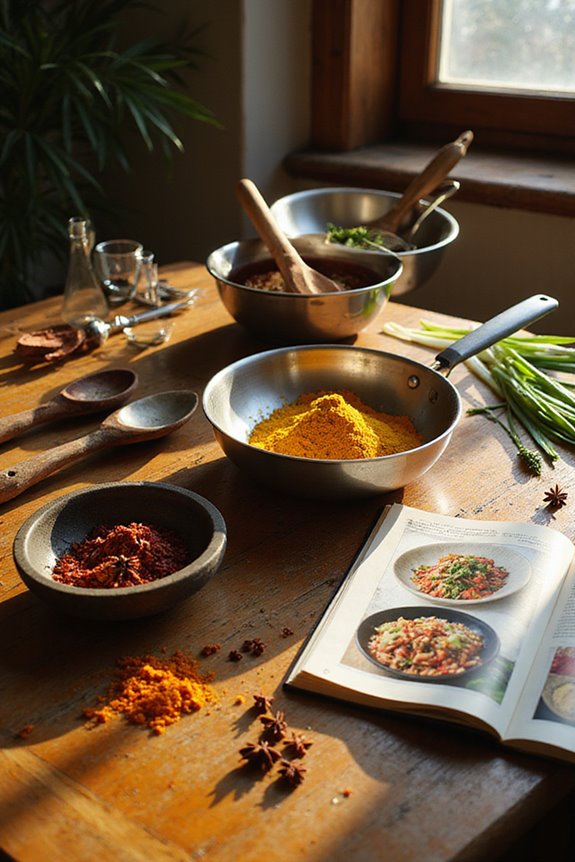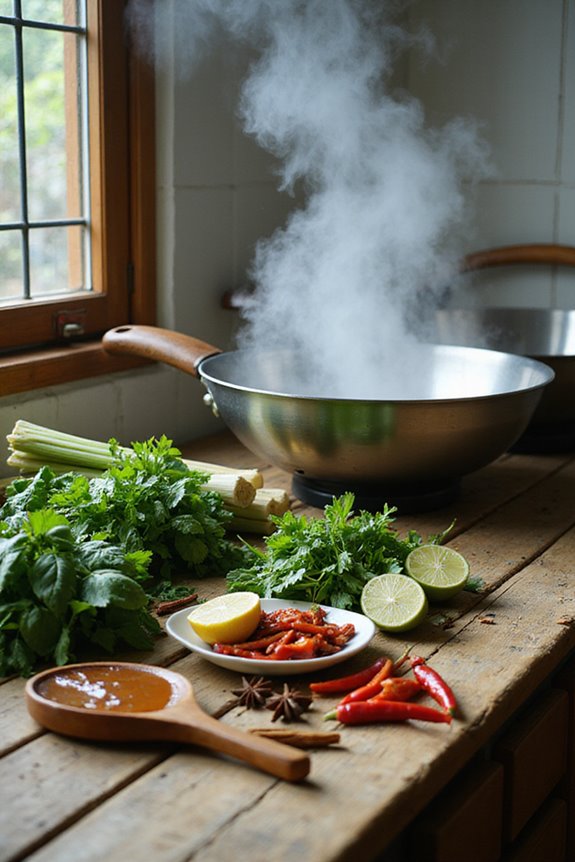Let’s whip up some delightful traditional Mongolian dishes together! Start with Buuz (dumplings) by mixing 300g minced meat with onions and spices, and wrap it in dough made from 250g flour and water. Feeling adventurous? Try Khuushuur, a pocket of happiness filled with spiced meat, fried until golden. For something warm, make Tsuivan noodles sautéed with veggies. Don’t forget to sweeten the day with Boortsog – fried cookies perfect for dipping! Stick around for more magical recipes!
Key Takeaways
- Choose traditional ingredients like lamb or mutton for authentic flavors in dishes like buuz and khuushuur.
- Prepare dough for dumplings or noodles by kneading flour with water and salt until smooth and elastic.
- Shape dumplings or meat pockets by forming dough into circles or ovals for filling with seasoned meat mixtures.
- Cook dishes using methods like frying for crispy textures or boiling for tender meat flavors, depending on the recipe.
- Enhance your meals with appropriate dipping sauces and additional vegetables for a hearty and fulfilling dining experience.
Ingredients for Traditional Mongolian Dumplings (Buuz)
When it comes to making traditional Mongolian dumplings, known as buuz, the ingredients play an essential role in crafting those delightful pockets of goodness. Let’s explore the magical world of filling options and dumpling variations! For that scrumptious filling, we usually go for about 300g of minced lamb, mutton, or beef. Don’t forget some finely chopped onions and a few cloves of minced garlic. Season with salt and black pepper, adding a dash of excitement with coriander if you’re feeling fancy.
As for the dough, we’ll need 250g of flour mixed with lukewarm water (about 150ml) and a pinch of salt for flavor. Air frying these dumplings can enhance their texture, creating a deliciously crispy exterior while locking in flavor. Shape it into circles, and get ready to create your own tasty tradition!
How to Prepare Fried Meat Pockets (Khuushuur)
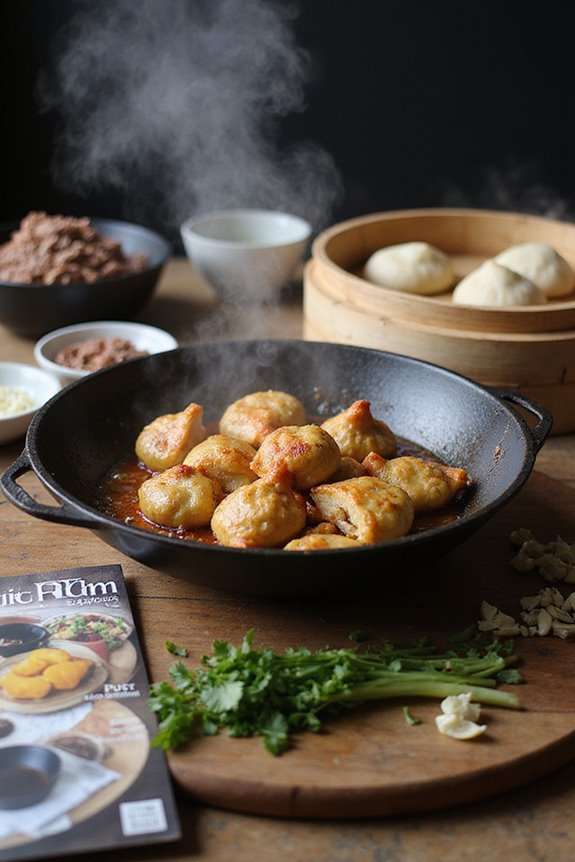
Get ready to plunge into the delightful world of making khuushuur, those tasty fried meat pockets that bring a touch of warmth and joy to any meal! Let’s keep our khuushuur history in mind as we prepare. First, we’ll mix 3 cups of all-purpose flour with 1 cup of water and knead until smooth. Next, we’ll fill dough circles with a mix of minced mutton, onion, and spices like cumin and coriander.
For frying techniques, heat about 1/2 cup of oil in a skillet to 350°F (180°C) and fry these beauties for 3–5 minutes per side. Remember, don’t overcrowd the pan. Once golden brown, drain on paper towels. Incorporating cultural significance into your meal can enhance the experience and deepen your appreciation for traditional dishes.
Enjoy your magical creation as a comforting snack or meal!
Step-by-Step Guide to Making Mongolian Noodle Stir-Fry (Tsuivan)
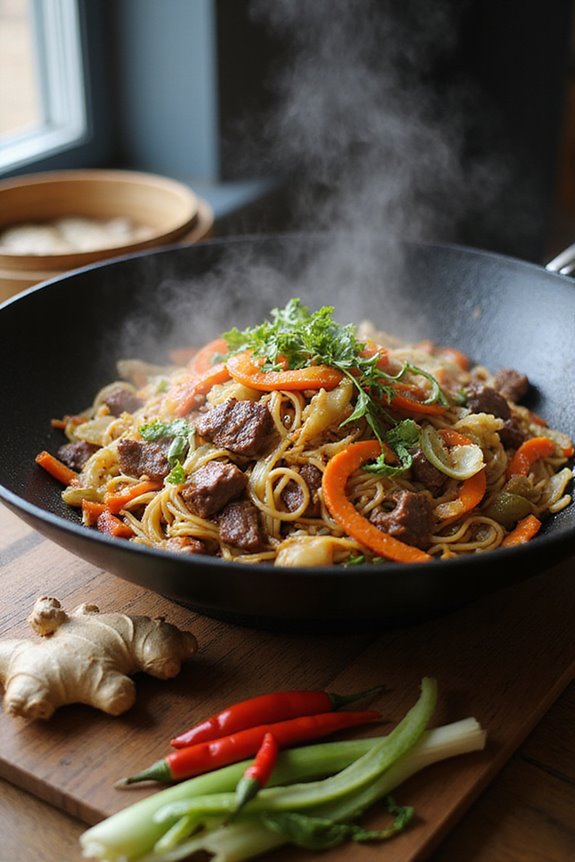
Let’s plunge into the delightful adventure of making Tsuivan, a delicious Mongolian noodle stir-fry that’s sure to warm your kitchen and your heart! To start, we mix 500g of all-purpose flour and 250ml of water to create our magical noodle dough. After kneading and letting it rest, we roll it out and cut it into thin strips. Next, we heat oil in a pan and sauté onions, meat—be it lamb or chicken—and a colorful mix of veggies! We pour water in and arrange our noodles before covering it all for a steaming wonder to happen. In the end, just add a sprinkle of salt and pepper, and voilà! Tsuivan brings everyone together for a feast! Utilizing ergonomic design in your kitchen tools can enhance your cooking experience by providing comfort and efficiency.
Preparing Fried Cookies (Boortsog)
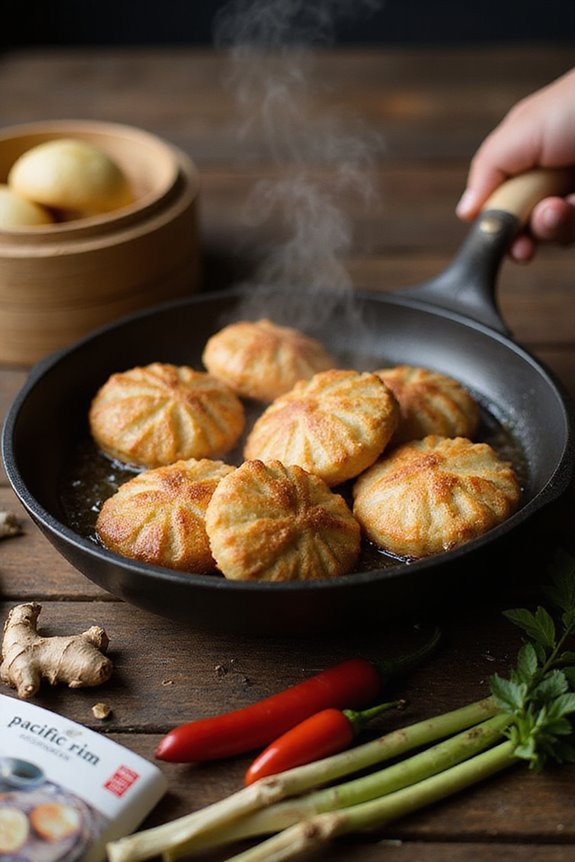
Preparing Fried Cookies, or Boortsog, is a delightful adventure that brings a little piece of Mongolia right into our kitchens! With a fun boortsog history dating back centuries, we’re embracing a traditional treat that’s beloved by many.
Let’s gather our ingredients:
- 2 to 4 cups all-purpose flour
- 1/4 to 1 cup butter or oil
- +/- 1/2 cup sugar
- A pinch of salt
- 1/2 cup warm water or milk
Next, we’ll mix the dough, knead it until it’s tough, and then shape it into fun variations—like knots or rectangles. After a quick fry in hot oil until golden brown, we can enjoy our warm Boortsog with tea, honey, or cheese! Experimenting with diverse flavors can elevate this dish and make it even more delightful. Happy cooking!
Cooking Boiled Meat Dishes (Buhel Mahan Zoog)
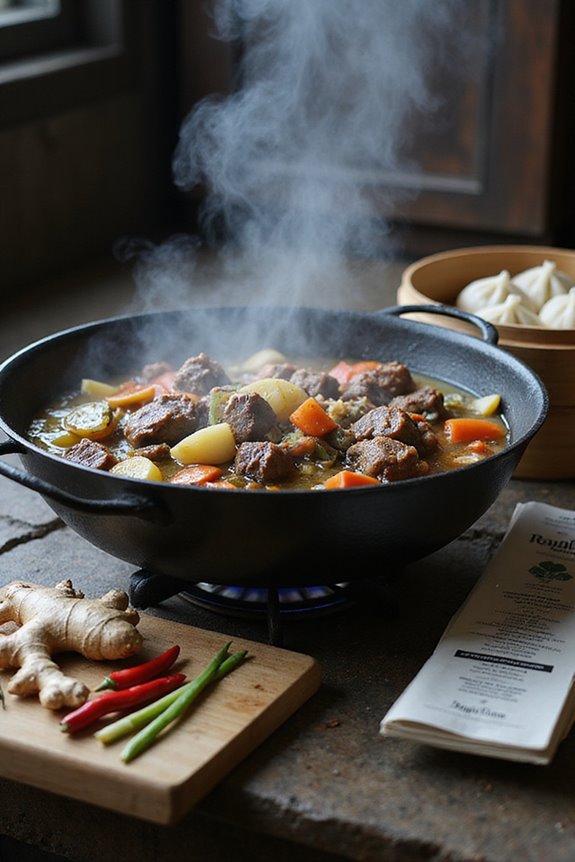
When we think of warming meals that bring us together, Buhel Mahan Zoog stands out as a true Mongolian masterpiece! To start, we’ll focus on meat selection, choosing chunk-sized pieces of fresh red meats like mutton or beef, with bones included for extra flavor. For the best results, opt for well-fed animals—this makes a delightful difference in the broth!
Next, let’s explore boiling techniques. We’ll simmer our meat in salted water until tender, which can take some time, but trust us, it’s worth it! To make it heartier, we can toss in potatoes or carrots. This dish is also complemented by a variety of dipping sauces to enhance the overall flavor experience. Enjoying this dish with family or friends really captures the spirit of Mongolian culture—perfect for cozy gatherings or winter celebrations!
Techniques for Traditional Mongolian Roasts (Boodog and Khorkhog)
Exploring the art of Boodog and Khorkhog brings a delightful twist to our traditional Mongolian cooking experience after our adventure with Buhel Mahan Zoog.
Boodog Techniques: For Boodog, we start by preheating stones and placing them inside a goat hide with meat, onions, and spices. Seal it tightly—it’s like a magical meat package!
Khorkhog Preparation: For Khorkhog, we place hot stones among chopped mutton or goat with veggies. The steam from the stones works wonders!
Both methods promote community bonding and celebrate our nomadic roots. Remember, patience is key; good things come to those who wait! So, gather your loved ones, and let’s make these heartwarming roasts unforgettable. To enhance your culinary experience, consider exploring air frying fish cakes as a delightful side dish that complements the bold flavors of Mongolian roasts.
Frequently Asked Questions
What Are Suitable Meat Alternatives for Mongolian Dishes?
When it comes to meat alternatives in Mongolian dishes, we’ve found that tofu substitutes and tempeh options can work wonders. Let’s explore vibrant flavors together and create meals that embrace tradition while being inclusive for all!
Can I Freeze Cooked Mongolian Dumplings for Later Consumption?
Yes, we can freeze cooked dumplings for later! By using proper reheating techniques like steaming or pan-frying, we’ll maintain their delicious flavor and texture. They’ll stay tasty in the freezer for 2-3 months.
How Can I Adjust Mongolian Recipes for Vegetarian Diets?
When adjusting Mongolian recipes for vegetarian diets, we can focus on protein substitutions and flavor enhancements. By incorporating tofu and fresh vegetables, we’ll create dishes that resonate with both tradition and our shared culinary journey.
What Traditional Beverages Pair Well With Mongolian Meals?
As we sip warm Mongolian tea, rich and inviting, we can’t help but think how perfectly it complements the unique taste of fermented mare’s milk. Together, they bring a sense of comfort and connection to our meals.
Where Can I Buy Authentic Mongolian Ingredients Outside Mongolia?
We can find authentic Mongolian ingredients by exploring local Mongolian markets and online retailers. Both offer a variety of essential staples, making it easier for us to connect with and savor our culinary heritage at home.

